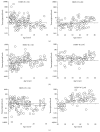Transcriptional activity of human endogenous retroviruses in human peripheral blood mononuclear cells
- PMID: 25734056
- PMCID: PMC4334862
- DOI: 10.1155/2015/164529
Transcriptional activity of human endogenous retroviruses in human peripheral blood mononuclear cells
Abstract
Human endogenous retroviruses (HERVs) have been implicated in human physiology and in human pathology. A better knowledge of the retroviral transcriptional activity in the general population and during the life span would greatly help the debate on its pathologic potential. The transcriptional activity of four HERV families (H, K, W, and E) was assessed, by qualitative and quantitative PCR, in PBMCs from 261 individuals aged from 1 to 80 years. Our results show that HERV-H, HERV-K, and HERV-W, but not HERV-E, are transcriptionally active in the test population already in the early childhood. In addition, the transcriptional levels of HERV-H, HERV-K, and HERV-W change significantly during the life span, albeit with distinct patterns. Our results, reinforce the hypothesis of a physiological correlation between HERVs activity and the different stages of life in humans. Studies aiming at identifying the factors, which are responsible for these changes during the individual's life, are still needed. Although the observed phenomena are presumably subjected to great variability, the basal transcriptional activity of each individual, also depending on the different ages of life, must be carefully considered in all the studies involving HERVs as causative agents of disease.
Figures



Similar articles
-
Human endogenous retroviruses and ADHD.World J Biol Psychiatry. 2014 Aug;15(6):499-504. doi: 10.3109/15622975.2013.862345. Epub 2013 Nov 28. World J Biol Psychiatry. 2014. PMID: 24286278
-
Transcriptional activity of human endogenous retroviruses is higher at birth in inversed correlation with gestational age.Infect Genet Evol. 2019 Mar;68:273-279. doi: 10.1016/j.meegid.2018.12.018. Epub 2018 Dec 19. Infect Genet Evol. 2019. PMID: 30578937
-
A New Insight on Activation of Human Endogenous Retroviruses (HERVs) in Malignant Melanoma upon Exposure to CuSO4.Biol Trace Elem Res. 2019 Sep;191(1):70-74. doi: 10.1007/s12011-018-1605-6. Epub 2018 Dec 11. Biol Trace Elem Res. 2019. PMID: 30539386
-
Human endogenous retroviruses in neurologic disease.APMIS. 2016 Jan-Feb;124(1-2):116-26. doi: 10.1111/apm.12486. APMIS. 2016. PMID: 26818266 Review.
-
Association of human endogenous retroviruses with multiple sclerosis and possible interactions with herpes viruses.Rev Med Virol. 2005 May-Jun;15(3):179-211. doi: 10.1002/rmv.465. Rev Med Virol. 2005. PMID: 15782388 Review.
Cited by
-
Reactivation of senescence-associated endogenous retroviruses by ATF3 drives interferon signaling in aging.Nat Aging. 2024 Nov 14. doi: 10.1038/s43587-024-00745-6. Online ahead of print. Nat Aging. 2024. PMID: 39543280
-
Acute strength exercise training impacts differently the HERV-W expression and inflammatory biomarkers in resistance exercise training individuals.PLoS One. 2024 May 16;19(5):e0303798. doi: 10.1371/journal.pone.0303798. eCollection 2024. PLoS One. 2024. PMID: 38753716 Free PMC article.
-
Beyond pathogens: the intriguing genetic legacy of endogenous retroviruses in host physiology.Front Cell Infect Microbiol. 2024 Apr 9;14:1379962. doi: 10.3389/fcimb.2024.1379962. eCollection 2024. Front Cell Infect Microbiol. 2024. PMID: 38655281 Free PMC article. Review.
-
Navigating the brain and aging: exploring the impact of transposable elements from health to disease.Front Cell Dev Biol. 2024 Feb 27;12:1357576. doi: 10.3389/fcell.2024.1357576. eCollection 2024. Front Cell Dev Biol. 2024. PMID: 38476259 Free PMC article. Review.
-
Spreading Senescent Cells' Burden and Emerging Therapeutic Targets for Frailty.Cells. 2023 Sep 15;12(18):2287. doi: 10.3390/cells12182287. Cells. 2023. PMID: 37759509 Free PMC article.
References
-
- Ohno S. So much ‘junk’ DNA in our genome. Brookhaven Symposia in Biology. 1972;23:366–370. - PubMed
Publication types
MeSH terms
LinkOut - more resources
Full Text Sources
Other Literature Sources
Medical


